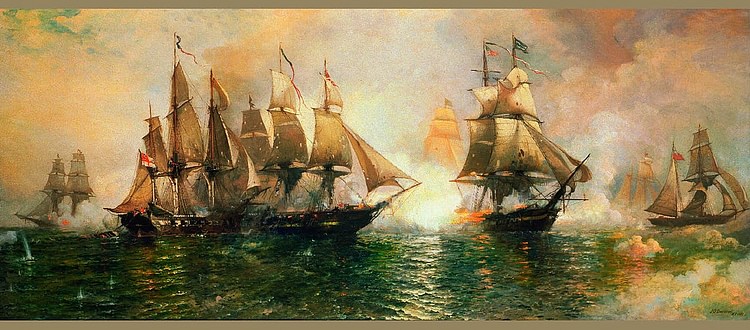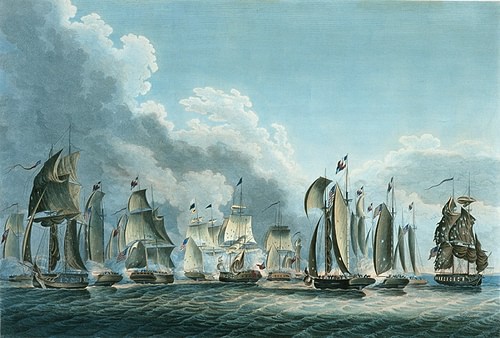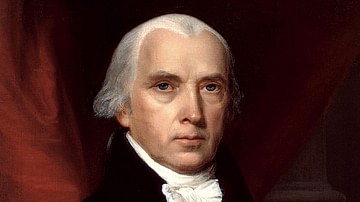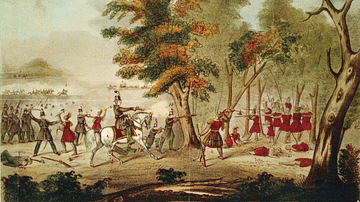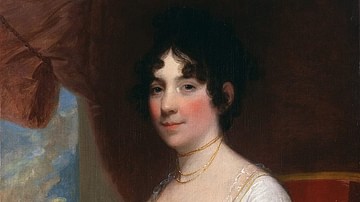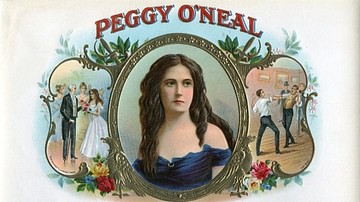
The War of 1812 (1812-1815), referred to by some contemporaries as the Second American Revolution, was fought between the United States and the United Kingdom. Often remembered only as a sideshow to the Napoleonic Wars, the war had some long-term impacts like the reduction of Native American political power and the strengthening of US and Canadian national identities.
Causes
Briefly summarized, the main causes of the War of 1812 include:
- Unresolved tensions between the US and UK left over from the American Revolution.
- Seizure of US merchant vessels and impressment of US sailors by the Royal Navy.
- Rise of an intertribal Native American confederacy led by the Shawnee chieftain Tecumseh, backed by British agents.
- The influence of the 'War Hawks', a clique of Democratic-Republican congressmen intent on driving Britain from North America, with desires of annexing British Canada.
Of these causes, the most important was the matter of impressment. Since 1793, Britain had been at war with France and often stopped and seized American vessels suspected of trading at French ports. While the French were also guilty of attacking American shipping, the British were seen as more egregious for the added layer of impressment; claiming that many American sailors were actually deserters from the Royal Navy, the British would routinely impress these sailors 'back' into service. The United States viewed this as an attack on its sovereignty, especially after American sailors were killed in the Chesapeake-Leopard affair of 1807. An outspoken group of congressmen called 'War Hawks' – notably including Henry Clay and John C. Calhoun – began to call for a 'Second War of Independence' and demand Britain be chased off the North American continent. While few openly called for the annexation of British Canada, this was certainly an outcome desired by many of the 'War Hawks'.
The Americans also accused the British of supporting a confederacy of Native American nations rising in the northwest. This confederacy was largely the work of two Shawnee brothers, Tecumseh and Tenskwatawa, who believed intertribal cooperation to be the only means of resisting US encroachment on their lands. The British agents in the region supported Tecumseh; they considered an independent Native American state an excellent buffer between the US and Canada. Hoping to crush this growing threat, Governor William Henry Harrison of the Indiana Territory set out to destroy the confederacy's headquarters at the village of Prophetstown. While encamped outside the town, Harrison was attacked by Tecumseh's warriors at the Battle of Tippecanoe (7 November 1811). Harrison won the battle and destroyed Prophetstown, with Tecumseh's Confederacy allying itself closer to the British.
By 1812, it was clear that the US and UK were on the brink of a war that few people actually wanted. In June, Britain decided to back down by revoking the Orders in Council that allowed for the impressment of US sailors. But it was too late – unaware of that development, US President James Madison asked Congress for a declaration of war against Britain on 18 June 1812, which was granted. This was a risky move, as the US Army was small and untrained, and its navy was hardly equal to the mighty Royal Navy. But many Americans were unconcerned, predicting a quick and easy conquest of Canada; in the words of former president Thomas Jefferson, the invasion of Canada would be nothing more difficult than 'a mere matter of marching' (Wood, 677).
Opening Maneuvers: June-November 1812
Although the Americans had been the ones to declare war, it would be the British who took the first decisive action. On 17 July 1812, a small British force surprised the American fort at Michilimackinac, an island located at the strategic juncture between Lake Michigan and Lake Huron. The American garrison, unaware that war had even been declared, was taken completely off guard and surrendered without a fight – by capturing the island, the British took control of the lucrative regional fur trade and convinced many of the neutral northwestern Native American nations to join their side.
At the same time, US Brigadier General William Hull, governor of the Michigan Territory, was leading an army across the Detroit River and into Canada. His goal was to capture Fort Amherstburg, the main British outpost in the region, before pushing on to invade the rest of Upper Canada. Hull managed to cross the river and set up headquarters in the Canadian town of Sandwich by 12 July but soon got cold feet. Feeling undersupplied, Hull did not want to attack the British fort without more artillery and, after learning of the fall of Michilimackinac, was terrified that a “great hive of Indians” would come “swarming down in every direction” (Berton, 140). Ultimately, Hull decided to abandon his invasion and retreated across the river, to the safety of Detroit.

As Hull retreated, British Major General Isaac Brock arrived to take command of the defense of Upper Canada. A career soldier beloved by his men, Brock was determined to win the military glory. On 13 August, he arrived in Amherstburg, where he was introduced to the great Tecumseh. The two took an instant liking to one another and quickly put together a plan to capture Detroit. On 15 August, Brock and Tecumseh began the siege of Detroit, using various methods of trickery to convince Hull that they had greater numbers of Native American warriors than they really did. Fearing that the Natives would slaughter his troops if he resisted, Hull agreed to surrender after a single day, giving up both Detroit and his entire army. At a stroke, the British had become masters of the entire Michigan Territory, while more Native Americans flocked to join Tecumseh's confederacy. For his part, Hull would ultimately be court-martialed and sentenced to death, though President Madison would commute this sentence.
Brock was not able to celebrate for long, as a second US army was gathering in New York State, preparing to cross the Niagara River. Taking advantage of a brief armistice, Brock was able to prepare his men for the American attack, which finally came in the early morning hours of 12 October at the Battle of Queenston Heights. Led by the wealthy New York politician Stephen Van Rensselaer, the Americans crossed the river in waves of boats, landing under heavy fire. Still, they managed to capture the high ground above Queenston; General Brock was killed while leading a countercharge to retake the heights. Despite this devastating blow to the British war effort, the British managed to force the Americans back across the river, winning yet another victory. As the campaign season came to an end, it was becoming clear that invading Canada would be much more difficult than a 'mere matter of marching'.
Border War: January-November 1813
As 1812 drew to a close, it became imperative for the Madison administration to recover Michigan and the fur country from the British. This task was entrusted to none other than Old Tippecanoe himself, William Henry Harrison, who marched north with an army comprised mainly of Kentucky volunteers. The advance column of his army made it to Frenchtown, a small community along the River Raisin in Michigan, where it was surprised and defeated by a British and Native American force on 22 January 1813. The surviving US troops were hauled back to Amherstburg as prisoners, while those too wounded to walk were left behind. In the coming hours, many of these men were slaughtered by the Native American warriors, in retaliation for the destruction the Kentuckians had wrought to their communities. The massacre following the Battle of the River Raisin only hardened many Americans against the British, blaming them for their use of Native American warriors in battle.
Harrison moved the remainder of his army into the newly built Fort Meigs along the Maumee River, where he waited out the winter. In the spring, he withstood the siege of Fort Meigs (28 April to 9 May), holding out against a British and Native American force led by Tecumseh and Sir Henry Procter. The Michigan front remained deadlocked throughout the summer, until US Master Commandant Oliver Hazard Perry won the hard-fought Battle of Lake Erie (10 September), securing US control of the lake. Supplied by Perry's fleet in Lake Erie, Harrison was able to advance deeper into Michigan, forcing Procter and Tecumseh to retreat. After recapturing Detroit, Harrison chased the British into Canada, culminating in the dramatic Battle of the Thames (5 October). Tecumseh was killed in the battle, with many Native American nations dropping out of the war after his death.
Meanwhile, the Americans were renewing their attacks across the Niagara River. On 27 April, US soldiers under Brigadier General Zebulon Pike attacked York (present-day Toronto), the provincial capital of Upper Canada. Although Pike was killed, the Battle of York resulted in an American victory, with US troops plundering the town afterwards; in the confusion, several public buildings caught fire, leading Canadian officials to accuse the Americans of intentionally burning York. A month later, the Americans won the Battle of Fort George (27 May), intending to use the fort as a base for an invasion of the Niagara Peninsula. Although they held the numerical advantage, the Americans were dealt several frustrating defeats at the battles of Stoney Creek (6 June) and Beaver Dams (24 June). Suffering from disease, the Americans were ultimately forced to abandon Fort George in December, giving up their foothold in Niagara. Around the same time, the British pushed their advantage by raiding the New York towns of Lewiston and Buffalo, and by capturing the American Fort Niagara.
Invasions: November 1813 to November 1814
As the war along the New York-Canadian border grew increasingly ugly, the US continued to look for ways to take the war deeper into Canadian territory. In the autumn of 1813, US Major General James Wilkinson led an army of 8,000 men into the St. Lawrence River Valley, with the goal of laying siege to Montreal. Wilkinson's invasion, however, got off to a rough start. Dysentery was plaguing the army, carrying off men at an alarming rate, while the invading Americans were hounded by a British gunboat flotilla that nipped at their heels. The Americans were finally checked at the Battle of Crysler's Farm (11 November 1813), a defeat that convinced Wilkinson – who was suffering from dysentery himself – to abandon the campaign before the onset of winter.
The next summer, the Americans renewed their attacks along the Niagara frontier. US Major General Jacob Brown surprised and captured the British outpost of Fort Erie before going on to meet the British soldiers at the Battle of Chippawa (5 July 1814). The battle was won by Brigadier General Winfield Scott, whose brigade of well-disciplined, gray-clad regulars held their own against professional British troops. For the next several weeks, the Niagara countryside became engulfed in blood and flames as American and Canadian militia units skirmished, the Americans torching several Canadian towns in retribution for the raids on Lewiston and Buffalo. This all culminated on 25 July, when the American and British armies clashed once again at the Battle of Lundy's Lane. Though the battle itself was a stalemate, it was among the bloodiest actions of the war, resulting in around 850 casualties on each side. The depleted American army was forced back into Fort Erie, where they prepared for a siege. Although the Americans ultimately won the ensuing siege of Fort Erie (4 August to 21 September 1814), they found that they could not hold the fort. In November, they blew it up and withdrew back across the river to US territory.
For the first two years of the war, the British had been forced to stay on the defensive; most of their military resources were being used to fight Napoleon in Europe, and they did not have the manpower to do much more than defend Canada. This all changed with the defeat and abdication of Napoleon in April 1814, allowing Britain to shift thousands of battle-hardened regulars to North America. Hoping to divert American attention away from Canada – and to get revenge for the Canadian towns burned by US troops – the British landed a force of 4,500 men on the shores of Chesapeake Bay on 19 August. Led by Major General Robert Ross, these troops swept aside the American militia force at the Battle of Bladensburg (24 August) before going on to capture the US capital of Washington, D.C. The British burned several public buildings, including the President's House (White House) and the Capitol Building.
Following the burning of Washington, the British went on to Baltimore, Maryland, where they were frustrated by the stubborn American defense of Fort McHenry. After a brief battle in which Ross was killed by a sharpshooter, the British abandoned Baltimore and sailed away, their main objective having been accomplished. The British also launched a simultaneous invasion of New York State but were repulsed at the Battle of Lake Champlain (11 September 1814).
War at Sea
Though the most decisive battles of the war took place on land, several notable actions took place at sea. The US Navy was still in its infancy and, at the beginning of the war, consisted of only eight frigates, 14 sloops, and no ships of the line. The Royal Navy, on the other hand, was at the height of its power in the aftermath of the Battle of Trafalgar (21 October 1805) and was made up of over 600 ships. Nevertheless, several single-ship actions took place on the high seas that would encourage the US and embarrass Britain. One of the most notable of these was when USS Constitution defeated HMS Guerriere on 19 August 1812; during the fight, a British broadside bounced off the Constitution's hull, earning it its nickname 'Old Ironsides'. Two months later, the American naval hero Stephen Decatur, captaining the USS United States, defeated and captured HMS Macedonian after a long duel, marking the first time a captured British warship was brought into a US harbor. These one-off naval victories, though of little strategic importance, raised US morale at a time when its army was embarrassing itself in Canada.
Of more significance were the fleets on the Great Lakes. By early 1813, both sides had realized that the lakes were the key to control Canada, leading them to embark on shipbuilding competitions on Lake Ontario. For much of the war, the British and American fleets on Lake Ontario did little more than sail around one another, with neither wishing to force a decisive battle that could result in losing control of the lake. The fleets patrolling Lake Erie proved much more daring; at the Battle of Lake Erie, Oliver Hazard Perry defeated the British fleet, seizing control of the lake for the Americans. It would be the largest naval battle of the war until the Battle of Lake Champlain a year later, where another American fleet halted the British invasion of New York. After the war, most of the American and British warships built on the Great Lakes would be dismantled.
Federalist Opposition
The War of 1812 was a deeply partisan affair. While the Democratic-Republican Party (Jeffersonian Republicans) supported the war as a way to rid their continent of British influence, the Federalist Party saw it as a mistake. The Federalists were generally pro-British, viewing the British Empire as a natural ally and trading partner of the US. Additionally, Federalist power was strongest in New England, a region that relied on trade that was hampered by the war. The Federalists opposed the war for the entirety of the conflict, but their resistance became more pronounced after the humiliating defeats of 1813-14. From 15 December 1814 to 5 January 1815, several Federalist delegates met at the Hartford Convention, to air their grievances over the war and discuss ways to limit the power of the Jeffersonians. The timing was terrible, as the war ended a little over a month after the convention. Republicans accused the Federalists of having planned to secede from the union, and painted them as traitors; the Federalists were never able to recover politically from their opposition to the War of 1812, and soon faded from the pages of history.
End of the War
In June 1814, after months of negotiations, peace talks were finally opened in the city of Ghent in the United Netherlands (modern Belgium). The American commissioners were all high-level diplomats including John Quincy Adams, Henry Clay, and Albert Gallatin, while the British sent minor officials since their best diplomats were off at the Congress of Vienna. After months of back-and-forth, a deal was hammered out that was quite generous to the Americans: the pre-war borders would be restored (status quo antebellum), and the British would quietly drop their support of a Native American state. This Treaty of Ghent was signed on 24 December 1814.
Before news of the peace reached North America, the US won a dazzling victory at the Battle of New Orleans (8 January 1815), where a ragtag army under General Andrew Jackson defeated a larger force of British regulars. Though the battle had no effect on the peace, it gave the Americans the sense that they had indeed won the war, or at least satisfied national honor by getting the last word. Congress ratified the Treaty of Ghent on 17 February 1815, officially ending the war. The war resulted in the strengthening of US and Canadian national identities, each having become more unified in its fight against the other. At the same time, it eroded the political power of the Native Americans in the northwest, ending any chance of them forming a confederacy to resist the aggression of US expansion.

